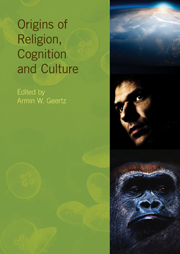Book contents
- Frontmatter
- Contents
- Contributors
- Introduction
- Part I EVOLUTIONARY SCENARIOS
- Part II COGNITIVE THEORIES
- 11 Cognition and meaning
- 12 Wittgenstein and the naturalness of religious belief
- 13 “Peekaboo!” and object permanence: on the play of concealment and appearance in cognition and religion
- 14 Yogācāra Buddhist views on the causal relation between language, cognition and the evolution of worlds
- 15 A resource model of religious cognition: motivation as a primary determinant for the complexity of supernatural agency representations
- 16 The recognition of religion: archaeological diagnosis and implicit theorizing
- 17 Religion and the extra-somatics of conceptual thought
- 18 Tools for thought: the ritual use of ordinary tools
- 19 Care of the soul: empathy in dualistic worldview
- 20 From corpse to concept: a cognitive theory on the ritualized treatment of dead bodies
- 21 Anthropomorphism in god concepts: the role of narrative
- Index
20 - From corpse to concept: a cognitive theory on the ritualized treatment of dead bodies
from Part II - COGNITIVE THEORIES
- Frontmatter
- Contents
- Contributors
- Introduction
- Part I EVOLUTIONARY SCENARIOS
- Part II COGNITIVE THEORIES
- 11 Cognition and meaning
- 12 Wittgenstein and the naturalness of religious belief
- 13 “Peekaboo!” and object permanence: on the play of concealment and appearance in cognition and religion
- 14 Yogācāra Buddhist views on the causal relation between language, cognition and the evolution of worlds
- 15 A resource model of religious cognition: motivation as a primary determinant for the complexity of supernatural agency representations
- 16 The recognition of religion: archaeological diagnosis and implicit theorizing
- 17 Religion and the extra-somatics of conceptual thought
- 18 Tools for thought: the ritual use of ordinary tools
- 19 Care of the soul: empathy in dualistic worldview
- 20 From corpse to concept: a cognitive theory on the ritualized treatment of dead bodies
- 21 Anthropomorphism in god concepts: the role of narrative
- Index
Summary
Religious participants all over the world ritually burn, bury, cremate, pickle, mummify, wrap, wash and decorate dead bodies. Archaeologists speculate that the religious act of dealing with dead bodies may go back even to the time of Neanderthals some 50,000 years ago (Mithen 1996: 20–21, 198–9). Small bands of hunter—gatherers thousands of years ago may have had the tendency to treat dead bodies in specific ways for emotional reasons, remove an unwanted object from their midst, or to raise their odds of survival; the loss of one or more (of a few hunters) might have resulted in disastrous consequences for the group heightening the significance of a death. Additionally, the kinds of actions surrounding death and dead bodies may represent one, if not the earliest documented, type of ritual behaviour (see Parker Pearson 1999).
What has puzzled scholars is exactly why people across cultures and throughout human history have exhibited the tendency to deal with dead bodies in ritualized ways. Buddhist participants, in particular, throughout history have performed elaborate rituals involving corpses and their remains, even though many doctrinal/philosophical texts in Buddhist traditions explicitly state that the body and its relics should not be ritualized and/or worshiped. Many explanations of corpse treatment have concentrated on various meanings associated with ritual behaviour, or lack thereof. Furthermore, these theories connect biology and culture without identifying the implicated connective cognitive processes. This article seeks to identify those cognitive processes that are triggered in response to dead bodies, and, therefore, play a role in informing the rituals surrounding death and burial.
- Type
- Chapter
- Information
- Origins of Religion, Cognition and Culture , pp. 374 - 395Publisher: Acumen PublishingPrint publication year: 2013

